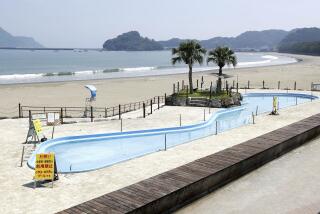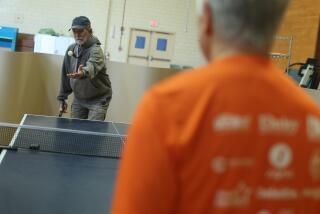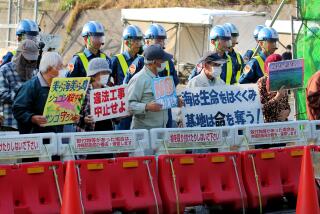Japan fears post-quake rise in suicides
- Share via
Reporting from Tokyo — Naoko Sugimoto has heard the news through the nation’s fledgling mental health grapevine, ominous reports of suicides in the region devastated by last month’s magnitude 9 earthquake and tsunami.
It’s a trickle she fears may soon become a river: the farmer who hanged himself, distressed about a cabbage harvest ruined by radioactive fallout from the Fukushima Daiichi nuclear power plant; the overworked government worker near the complex who took his life; the father who killed himself after a fruitless search for his child after the tsunami.
“I feel sorry for these people in the same way I do for those who died in the tsunami,” said Sugimoto, 67, who heads a national suicide support group, Izoku Shien. “But they didn’t die in the tsunami; they died afterward. They took their own lives. And that makes you ask yourself, ‘What could we have done?’”
As Japan rebuilds from the March 11 disaster, public health officials worry that a lingering sense of hopelessness among those affected might lead to a surge in suicides in a nation already coping with one of the developed world’s highest rates of self-inflicted deaths. They have created suicide hotlines, pumped more money into therapy programs and sent more suicide counselors into the field as they wait and worry.
In the coming months, as those displaced by the quake and tsunami seek to move on with their lives, the true gravity of the disaster will slowly sink in for many, say government officials, aid organizations and mental health workers.
Some who have lost homes, family and friends probably will ask: “What do I have to live for?”
Accurate statistics are not available, but the nation experienced a rise in suicides after the 1995 Kobe earthquake that killed more than 6,400 people. Those who chose to die included the city’s deputy major, who doused himself with kerosene on the first anniversary of the disaster, Sugimoto said.
Now she frets about the soldiers and police officers who have spent weeks on the grim search for bodies, as well as nuclear plant employees working overtime to deal with the crippled reactor.
“They’re all vulnerable to the effects of the disaster, which will take time to sink in,” she said.
Japan’s view of taking one’s own life does not carry the connotations of sin or mental illness that it does in the West. For centuries, the country has maintained a romanticized notion of the noble suicide, fueled by tales of samurai warriors and World War II kamikaze pilots.
In 2007, after a Japanese Cabinet minister hanged himself with a dog leash while under investigation in for a series of political scandals, a national politician remarked that the minister “was a true samurai” because he had taken his life to preserve his honor.
Japan now confronts a suicide toll that soared after the 1997 Asian financial crisis and has reached 30,000 a year for 13 consecutive years.
Every 15 minutes, someone takes his or her own life in the island nation of 127 million, establishing suicide as the leading cause of death among Japanese men ages 20 to 44 and women ages 15 to 34.
Further, March is typically the month with the highest number of suicides, at the end of the Japanese fiscal year. Many of the deaths are “responsibility-driven” suicides by people hoping to make up for outstanding debts through a life insurance payout, experts say.
“There’s something like 11 different cultural classifications for suicide in Japan; for the most part, there remains some sympathy for the act,” said Gaithri Fernando, an assistant professor of psychology at Cal State Los Angeles who has conducted research on how culture affects a person’s response to trauma.
“More than half the suicides each year are due to financial reasons, to win back collateral that friends and family had put on the line. It’s become a macabre way to pay your debts.”
Last month’s disaster struck in northeastern Japan, a region that has traditionally grappled with higher suicide rates. A decade ago, the prefectures on the northern tip of Honshu, Japan’s main island, faced suicide rates that were double the national average, a trend experts linked to the region’s stoicism, inclement weather and preponderance of elderly shut-ins.
In 2007, central government officials passed a law requiring municipalities to help stem the rising rate nationwide, mandating that each prefecture fund a prevention office.
The suicide rate in northern Honshu has since dropped. But three prefectures in hard-hit disaster areas recently created a suicide hotline just for survivors, Sugimoto said.
Fernando said the Japanese government should establish a financial safety net for farmers, fishermen and others whose livelihoods have been hurt by the disaster.
“The potential for depression is out there,” she said. “It’s not just driven by the big traumas; it’s the years afterward when people try to rebuild their lives, the daily hassles of getting water, kids with no electricity,” she said.
Family members said the Fukushima prefecture farmer who took his life believed he had lost “everything he had ever worked for during his life.” The man’s daughter told reporters, “We have no idea how long this situation will continue. What will become of us? I think everyone involved in agriculture is worried. I pray there will be no more victims like my father.”
Sugimoto has the same hope.
“We never know what we have waiting for us on the next page of our lives,” she said. “People need to wait and see what happens.”
More to Read
Sign up for Essential California
The most important California stories and recommendations in your inbox every morning.
You may occasionally receive promotional content from the Los Angeles Times.











